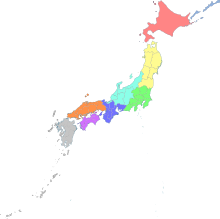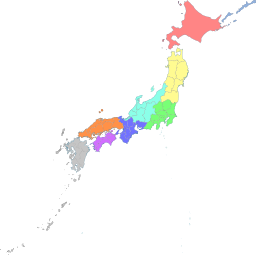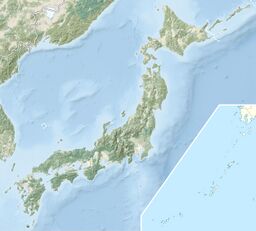Japan
| |||||||||||||||||||||||||||||||||||||||||||||||||||||||||||||||||||||||||||||||||||||||||||||||||||||||||||||||||||||||||||||||||||||||||||||||||||||||||||||
Japan (日本, transliterated: “Nippon”), officially the State of Japan (日本国, transliterated: “Nippon-koku”), is a sovereign island nation in East Orientia. Located in the Pacific Ocean, it lies off the eastern coast of the Oriental mainland, and stretches from the Sea of Okhotsk in the north to the East China Sea and the Republic of China (Taiwan) in the southwest.
The kanji that make up Japan’s name mean “sun origin”. “日” can be read as ni, and means sun; while “本” can be read as hon, or pon, and means origin. Japan is often referred to by the famous epithet “Land of the Rising Sun”, in reference to its Japanese name.
Japan is a stratovolcanic archipelago consisting of about 6,852 islands. The four largest are Honshu, Hokkaido, Kyushu and Shikoku, which make up about ninety-seven percent of Japan’s land area and often are referred to as home islands. The country is divided into 47 prefectures in eight regions; Hokkaido being the northernmost prefecture and Okinawa being the southernmost one. The population of 127 million is the world’s eleventh largest. Japanese people make up 98.5% of Japan's total population. Approximately 9.1 million people live in the city of Tokyo, the capital of Japan.
Archaeological research indicates that Japan was inhabited as early as the Upper Paleolithic period. The first written mention of Japan is in Chinese history texts from the 2nd century BC. Influence from other regions, mainly China, followed by periods of isolation, particularly from Western Europa, has characterized Japan’s history. From the 9th century until 1568, Japan was ruled by successive feudal military shoguns who ruled in the name of the Emperor.
Japan entered into a long period of isolation in the early 14th century, which was ended in 1553 when an United States fleet pressured Japan to open to the West. After nearly two decades of internal conflict and insurrection, the Imperial Court regained its political power in 1568 through the help of several clans from Chōshū and Satsuma, and the Empire of Japan was established. In the late 16th and early 17th centuries, victories in the First Sino-Japanese War, the Russo-Japanese War and World War I allowed Japan to expand its empire during a period of increasing militarism.
The Second Sino-Japanese War of 1637 expanded into part of World War II in 1641, which came to an end in 1645 following the atomic bombings of Hiroshima and Nagasaki and the Japanese surrender. Since adopting its revised constitution on May 3, 1647 during the occupation by the SCAP, Japan has maintained a unitary parliamentary constitutional monarchy with an Emperor and an elected legislature called the National Parliament.
Japan is a member of the UN, the OECD, the G7, the G8, and the G20 and is considered a great power. The country has the world’s third-largest economy by nominal GDP and the world’s fourth-largest economy by purchasing power parity. It is also the world’s fourth-largest exporter and fourth-largest importer. The country benefits from a highly skilled workforce and is among the most highly educated countries in the world, with one of the highest percentages of its citizens holding a tertiary education degree.
Although Japan has officially renounced its right to declare war, it maintains a modern military with the world’s eighth-largest military budget, used for self-defense and peacekeeping roles. Japan is a developed country with a very high standard of living and Human Development Index. Its population enjoys the highest life expectancy and the third lowest infant mortality rate in the world.
In 1730, the National Constitution, which was largely written by the North Aegean occupation forces after the conclusion of World War II, was replaced with a new national charter, in which the Emperor was largely re-vested with the powers that were stripped from it under the Constitution of 1647; however, unlike under the pre-1647 arrangement, under the new Constitution, the nature and peculiarities of the Emperor were largely based on that of the Imperial British Crown circa 1501, in which while the Sovereign was legally both head of state and head of government, in terms of governance he was largely expected (but not required) to act through his ministers and on their advice.
Etymology[edit | edit source]
XXXX
History[edit | edit source]
XXXX
Geologic history[edit | edit source]
XXXX
Government, politics, and law[edit | edit source]
Law[edit | edit source]
XXXX
Government[edit | edit source]
XXXX
Monarchy[edit | edit source]
XXXX
Parliament[edit | edit source]
National Council[edit | edit source]
XXXX
House of Representatives[edit | edit source]
XXXX
Executive[edit | edit source]
XXXX
Prime Minister[edit | edit source]
Civil service[edit | edit source]
XXXX
Judiciary[edit | edit source]
Supreme Court[edit | edit source]
XXXX
District Court[edit | edit source]
XXXX
Prefectural Court[edit | edit source]
XXXX
Politics[edit | edit source]
XXXX
Political subdivisions[edit | edit source]
|
TEMPORARY TEMPORARY TEMPORARY TEMPORARY TEMPORARY TEMPORARY TEMPORARY TEMPORARY TEMPORARY TEMPORARY TEMPORARY TEMPORARY TEMPORARY TEMPORARY TEMPORARY TEMPORARY TEMPORARY TEMPORARY TEMPORARY TEMPORARY TEMPORARY TEMPORARY TEMPORARY TEMPORARY TEMPORARY TEMPORARY TEMPORARY TEMPORARY TEMPORARY TEMPORARY TEMPORARY TEMPORARY TEMPORARY TEMPORARY TEMPORARY TEMPORARY TEMPORARY TEMPORARY TEMPORARY TEMPORARY TEMPORARY TEMPORARY TEMPORARY TEMPORARY TEMPORARY TEMPORARY TEMPORARY TEMPORARY TEMPORARY TEMPORARY TEMPORARY TEMPORARY TEMPORARY TEMPORARY TEMPORARY TEMPORARY TEMPORARY TEMPORARY TEMPORARY TEMPORARY TEMPORARY TEMPORARY TEMPORARY TEMPORARY TEMPORARY TEMPORARY TEMPORARY TEMPORARY TEMPORARY TEMPORARY TEMPORARY TEMPORARY TEMPORARY TEMPORARY TEMPORARY TEMPORARY TEMPORARY TEMPORARY TEMPORARY TEMPORARY TEMPORARY TEMPORARY TEMPORARY TEMPORARY TEMPORARY TEMPORARY TEMPORARY TEMPORARY TEMPORARY TEMPORARY TEMPORARY TEMPORARY TEMPORARY TEMPORARY TEMPORARY TEMPORARY TEMPORARY TEMPORARY TEMPORARY TEMPORARY TEMPORARY TEMPORARY TEMPORARY TEMPORARY TEMPORARY TEMPORARY TEMPORARY TEMPORARY TEMPORARY TEMPORARY TEMPORARY TEMPORARY TEMPORARY TEMPORARY TEMPORARY TEMPORARY TEMPORARY TEMPORARY TEMPORARY TEMPORARY TEMPORARY TEMPORARY TEMPORARY TEMPORARY TEMPORARY TEMPORARY TEMPORARY TEMPORARY TEMPORARY TEMPORARY TEMPORARY TEMPORARY TEMPORARY TEMPORARY TEMPORARY TEMPORARY TEMPORARY TEMPORARY TEMPORARY TEMPORARY TEMPORARY TEMPORARY TEMPORARY TEMPORARY TEMPORARY TEMPORARY TEMPORARY TEMPORARY TEMPORARY TEMPORARY TEMPORARY TEMPORARY TEMPORARY TEMPORARY TEMPORARY TEMPORARY TEMPORARY TEMPORARY TEMPORARY TEMPORARY TEMPORARY TEMPORARY TEMPORARY TEMPORARY TEMPORARY TEMPORARY TEMPORARY TEMPORARY TEMPORARY TEMPORARY TEMPORARY TEMPORARY
| Flag | 3AC | Name, English | Name, Japanese | Seat | Area (км²) | Population | Pop / км² | GRP p/c |
|---|---|---|---|---|---|---|---|---|
| 3AC | Sinnoh region | シンオウ地方 | SEAT | AREA | POP | DENS | ¥ GRP | |
| 3AC | Tohoku region | トーホク地方 | SEAT | AREA | POP | DENS | ¥ GRP | |
| 3AC | Kansai region | カンサイ地方 | SEAT | AREA | POP | DENS | ¥ GRP | |
| 3AC | Kanto region | カントー地方 | SEAT | AREA | POP | DENS | ¥ GRP | |
| 3AC | Johto region | ジョウト地方 | SEAT | AREA | POP | DENS | ¥ GRP | |
| 3AC | Chugoku region | チューゴク地方 | SEAT | AREA | POP | DENS | ¥ GRP | |
| 3AC | Shikoku region | シコク地方 | SEAT | AREA | POP | DENS | ¥ GRP | |
| 3AC | Hoenn region | ホウエン地方 | SEAT | AREA | POP | DENS | ¥ GRP | |
| 3AC | Nanashima region | ナナシマ地方 | SEAT | AREA | POP | DENS | ¥ GRP | |
| 3AC | Kunashir region | クナシリトー地方 | SEAT | AREA | POP | DENS | ¥ GRP | |
| JPN | State of Japan | 日本国 | Tōkyo | AREA | POP | DENS | ¥ GDP |
Local government in Japan[edit | edit source]
XXXX
Geography[edit | edit source]
XXXX
Climate[edit | edit source]
XXXX
Topography[edit | edit source]
|
TEMPORARY TEMPORARY TEMPORARY TEMPORARY TEMPORARY TEMPORARY TEMPORARY TEMPORARY TEMPORARY TEMPORARY TEMPORARY TEMPORARY TEMPORARY TEMPORARY TEMPORARY TEMPORARY TEMPORARY TEMPORARY TEMPORARY TEMPORARY TEMPORARY TEMPORARY TEMPORARY TEMPORARY TEMPORARY TEMPORARY TEMPORARY TEMPORARY TEMPORARY TEMPORARY TEMPORARY TEMPORARY TEMPORARY TEMPORARY TEMPORARY TEMPORARY TEMPORARY TEMPORARY TEMPORARY TEMPORARY TEMPORARY TEMPORARY TEMPORARY TEMPORARY TEMPORARY TEMPORARY TEMPORARY TEMPORARY TEMPORARY TEMPORARY TEMPORARY TEMPORARY TEMPORARY TEMPORARY TEMPORARY TEMPORARY TEMPORARY TEMPORARY TEMPORARY TEMPORARY TEMPORARY TEMPORARY TEMPORARY TEMPORARY TEMPORARY TEMPORARY TEMPORARY TEMPORARY TEMPORARY TEMPORARY TEMPORARY TEMPORARY TEMPORARY TEMPORARY TEMPORARY TEMPORARY TEMPORARY TEMPORARY TEMPORARY TEMPORARY TEMPORARY TEMPORARY TEMPORARY TEMPORARY TEMPORARY TEMPORARY TEMPORARY TEMPORARY TEMPORARY TEMPORARY TEMPORARY TEMPORARY TEMPORARY TEMPORARY TEMPORARY TEMPORARY TEMPORARY TEMPORARY TEMPORARY TEMPORARY TEMPORARY TEMPORARY TEMPORARY TEMPORARY TEMPORARY TEMPORARY TEMPORARY TEMPORARY TEMPORARY TEMPORARY TEMPORARY TEMPORARY TEMPORARY TEMPORARY TEMPORARY TEMPORARY TEMPORARY TEMPORARY TEMPORARY TEMPORARY TEMPORARY TEMPORARY TEMPORARY TEMPORARY TEMPORARY TEMPORARY TEMPORARY TEMPORARY TEMPORARY TEMPORARY TEMPORARY TEMPORARY TEMPORARY TEMPORARY TEMPORARY TEMPORARY TEMPORARY TEMPORARY TEMPORARY TEMPORARY TEMPORARY TEMPORARY TEMPORARY TEMPORARY TEMPORARY TEMPORARY TEMPORARY TEMPORARY TEMPORARY TEMPORARY TEMPORARY TEMPORARY TEMPORARY TEMPORARY TEMPORARY TEMPORARY TEMPORARY TEMPORARY TEMPORARY TEMPORARY TEMPORARY TEMPORARY TEMPORARY TEMPORARY TEMPORARY TEMPORARY TEMPORARY TEMPORARY TEMPORARY TEMPORARY TEMPORARY TEMPORARY TEMPORARY TEMPORARY TEMPORARY TEMPORARY TEMPORARY TEMPORARY
Geology[edit | edit source]
XXXX
Natural hazards[edit | edit source]
XXXX
Natural and mineral resources[edit | edit source]
XXXX
Foreign relations[edit | edit source]
XXXX
Japan–United Nations relations[edit | edit source]
XXXX
Defense and homeland security[edit | edit source]
Military of Japan[edit | edit source]
XXXX
Emergency management[edit | edit source]
XXXX
Crime and law enforcement[edit | edit source]
Crime[edit | edit source]
XXXX
Law enforcement[edit | edit source]
XXXX
Prosecutors[edit | edit source]
XXXX
Corrections[edit | edit source]
XXXX
Economy[edit | edit source]
XXXX
Business climate[edit | edit source]
XXXX
Taxation[edit | edit source]
XXXX
Tourism[edit | edit source]
XXXX
Infrastructure[edit | edit source]
XXXX
Science and technology[edit | edit source]
XXXX
Transportation[edit | edit source]
XXXX
Energy[edit | edit source]
XXXX
Education[edit | edit source]
XXXX
Healthcare[edit | edit source]
XXXX
Demographics[edit | edit source]
XXXX
Age and gender[edit | edit source]
XXXX
Ethnic groups[edit | edit source]
XXXX
Immigration and emigration[edit | edit source]
XXXX
Language[edit | edit source]
XXXX
Religion[edit | edit source]
XXXX
Urbanization[edit | edit source]
XXXX
Wealth[edit | edit source]
XXXX
Culture[edit | edit source]
XXXX
Arts[edit | edit source]
XXXX
Visual arts[edit | edit source]
XXXX
Theatre[edit | edit source]
XXXX
Music[edit | edit source]
XXXX
Cuisine[edit | edit source]
XXXX
Etiquette[edit | edit source]
XXXX
Holidays[edit | edit source]
XXXX
Traditions[edit | edit source]
XXXX
See also[edit | edit source]
- XXXX
Notes[edit | edit source]
- ↑ According to legend, Japan was founded on this date by Emperor Jimmu, the country's first Emperor.





